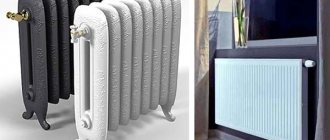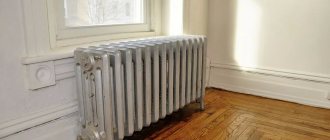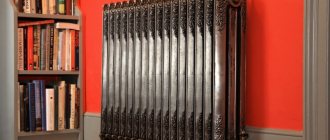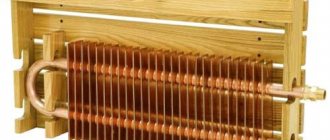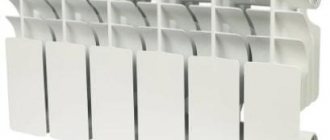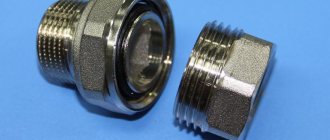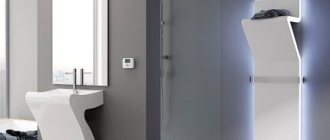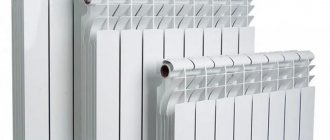High-quality heating of premises is important for residents of the entire Russian territory, which is characterized by harsh winters, long springs and early cold autumns. Heating devices are constantly being improved, so modern systems are distinguished by their efficiency and reliability. Aluminum heating radiators, which have their own design features and advantages, are considered relevant today.
Features of aluminum radiators
Aluminum batteries appeared on sale back in the 80s of the 20th century, and since then almost 70% of buildings are equipped with just such structures. In Soviet times, cast iron products were still popular, but due to certain shortcomings they were quickly replaced by modern appliances.
In what systems can it be used?
Aluminum batteries are successfully installed in both central and autonomous systems. But in order for the design to last for a really long time, you need to choose high quality batteries. The market for these devices is rapidly expanding, which is why unscrupulous manufacturers are appearing, producing low-quality products.
The heating system can be central and autonomous, respectively for an apartment building and a private house.
What is the difference between autonomous heating and central heating:
- low working pressure;
- there are no water hammers;
- it is possible to adjust the temperature of the coolant;
- acid balance is regulated;
- efficiency.
When designing any system, the first thing you should take care of is choosing a specific type of radiator. The durability, efficiency and cost-effectiveness of the batteries will depend on this.
An important role is played by the properties of the material itself - aluminum. It is lightweight, does not cause difficulties during installation and provides a high level of heat transfer.
Disadvantages of using aluminum batteries in a central heating system:
- Increased gas formation. Gases will begin to accumulate at the top of the batteries, which will not only lead to the appearance of bubbles, but also an increase in pressure. The latter situation is possible if both taps at the inlet to the radiator are closed, that is, it is cut off from the system. If it remains in this position for a long time, the risk of rupture increases. To avoid this, you should install an automatic air vent. It is also not recommended to turn off 2 taps at once. It is enough to close one and the battery will stop heating.
- Increased thermal expansion. As the battery heats up and cools down, it can create a characteristic metallic noise. This is explained by the friction of the device on the brackets. The problem is easily resolved: rubber covers are installed on the fasteners. As a rule, such problems do not arise with proper installation.
- Aluminum is a chemically active material. Accordingly, it is necessary to take into account the characteristics of the coolant, namely, hardness and acidity indicators. Acceptable values can be found in the product data sheet. If you neglect this issue, the battery life will be shortened.
Advantages
Aluminum batteries quickly conquered the heating equipment market, which is explained by their technical characteristics and advantages.
Among the advantages of use are the following:
- Light weight. Aluminum is not the rarest material, and accordingly, the cost of products remains affordable.
- Easy installation. You do not need any special skills to install batteries. Assembly and disassembly are not difficult, especially considering the light weight of the products.
- Design. Modern batteries have an attractive appearance, so they can be installed in rooms with different interiors. They do not need to be covered with special screens to hide their unpresentable appearance.
- Easy cleaning. You don’t have to turn to specialists; all work can be easily done with your own hands.
- Special heat-resistant coating. For this purpose, a special paint is used that does not lose its appearance for many years, that is, the user will not have to repaint the radiator after a couple of years.
- Heat transfer indicator. Aluminum appliances heat a large room in a short time without any particular difficulty.
Additionally, special heat-resistant heads can be installed. They allow you to regulate the heat supply. To achieve the desired heating result, you need to choose devices wisely, taking into account the power and number of sections.
Flaws
Unfortunately, ideal products simply do not exist these days. Any system or design has certain disadvantages that must be immediately taken into account.
Disadvantages of aluminum products:
- Low strength of the material. It is a soft metal that can easily be damaged under increased mechanical stress. For this reason, batteries are transported in special packaging. Often the radiator is covered with a screen for protective purposes; this point is especially important when installing equipment in industrial premises.
- Airing the system. Due to the air lock, the radiator cannot fully warm up, thereby reducing its efficiency. To bleed air, there are special taps included in the kit. Professionals recommend installing an automatic device.
There are some shortcomings, but it’s difficult to call them particularly serious. The only thing you need to do is to adhere to proper operation and try not to damage the batteries. In this case, they can last a long time, effectively heating the home.
Specifications
There are several parameters that you need to pay attention to when choosing aluminum batteries. If all the requirements are taken into account, the radiators will last a long time and will not cause any difficulties during operation.
Axle distance
Standard values found on the heating equipment market: 500, 350 and 200 mm. But the center distance may be different from the classical parameters. There are models from 200 to 800 mm.
Before purchasing a battery, you need to know how much free space there is under the window sill, since the radiators will be mounted in this place. It is not recommended to install them end-to-end - this will complicate the free circulation of warm air, which will impair heating.
You also need to pay attention to the width - all sections of equipment must fit into the installation niche. If the radiator’s dimensions do not fit, then you should choose another, more suitable model. For example, if the center distance is 350 mm, the height of the equipment increases by 100 mm, which also needs to be taken into account.
Pressure
Battery data sheets indicate 2 types of pressure: working and pressure testing. The latter is always higher. Sometimes you can find the value of the maximum permissible pressure. The average user, as a rule, does not know what all this means.
Operating pressure is that which is necessary for full operation of the battery. This indicator for aluminum products varies from 10 to 15 atm. These are the parameters that are typical for central heating systems.
As for the crimping pressure, in some ways it is even more important than the working pressure. After the summer period, when all water is removed from the system, you need to make sure it is tight before starting it up. For this purpose, pressure testing is used with a pressure higher than the working one at least 1.5 times. The indicator can rise to 30 atm. This procedure is used in central heating systems.
Note! Manufacturers do not always use the atmospheric unit to indicate pressure. There are also bars where 1 bar = 1 atm. Sometimes pressure may be indicated in MPa (megapascals). To understand how much it is in atmospheres, the parameter is multiplied by 10. That is, 1.2 MPa = 12 atm.
It is important to understand that work pressure differs in apartment buildings and private buildings. In general, pressure indicates how high water in a system can rise. 1 atm. capable of pushing water to a height of 10 meters. For a three-story house, this parameter is sufficient, but if there are 4 floors, then it will not be enough. It happens that utility companies do not adhere to a strict pressure indicator, giving it either less or more than necessary.
For this reason, when purchasing batteries, it is recommended to choose a model with a pressure reserve. Such products not only withstand loads well, but also last longer.
Thermal qualities
Aluminum radiators emit half of the heat generated in the form of rays. The remaining part is necessary for convection of air currents. To increase heat transfer, manufacturers make the inner surface of the sections ribbed. The thermal efficiency coefficient is measured in watts and is usually indicated for 1 section.
As an illustrative example, consider a battery with a distance between the axes of 500 mm. The heat transfer parameter here varies from 100 to 150 W. To obtain the total result required for thermal calculations, this indicator is multiplied by the number of sections.
As heat transfer increases, the inertia of the battery decreases. This is what makes aluminum radiators so economical. In this regard, they benefit from cast iron and modern bimetallic options. In addition, for the system to operate efficiently, the coolant does not have to be heated to particularly high temperatures, which, in turn, extends the service life of the equipment.
Lifetime
On average, aluminum radiators last from 20 to 25 years. Manufacturers provide a 5-year warranty on them. For batteries to really last that long, you need to adhere to proper operation, and in this matter, aluminum products are quite sensitive. There are many factors that can affect service life.
Thus, radiators do not withstand high pressure well and are poorly resistant to water hammer. Due to the increased acidity of the coolant, corrosion may occur inside the batteries. It is not recommended to leave the system without water for a long time; this also increases the likelihood of rust formation.
We can conclude that aluminum batteries serve effectively in autonomous heating systems, where, as a rule, the quality of the coolant is several times higher. The same applies to the stability of working pressure. It is these conditions that will ensure a long service life of the system.
Appearance
When purchasing batteries, many users pay attention to how the devices look. Modern aluminum radiators have a presentable appearance, which allows them to be installed both in residential premises and various establishments. Some models may differ in design, but in general they look great in modern interiors.
When choosing, it is better not to save money and invest in really high-quality equipment that will retain its appearance even after many years of service.
Types of aluminum batteries
Depending on the production technology, there are 3 main types of aluminum radiators. Everyone has both strengths and weaknesses. Having dealt with this issue, you can understand which batteries to buy in a particular situation.
Cast
For their production, injection molding technology is used. Such batteries are made from an alloy of aluminum and silicon EN AB 46100. If the product is European, it is made from a certified primary alloy, which provides the necessary strength and minimizes the likelihood of corrosion.
At the moment, cast aluminum batteries are the most in demand, which is why they are so common in Russia.
Extrusion
During manufacturing, sections of the radiator are first extruded under high pressure, for which an extruder is used. The equipment is then pressed or welded to the lower and upper manifolds. Often, in order to reduce the cost of the technological process, composite glue is used to connect sections. Such radiators, compared to cast ones, are less durable and leak more often.
When purchasing, you need to be careful, since extrusion radiators can be passed off as cast. The main visual difference between them is the characteristic seams on the inner side ribs.
Anodized
Such models are the most expensive. For their production, purified aluminum (98%) is used. Additionally, the entire surface of the batteries is coated with anodic oxidation. This allows you to change the structure of the material, making it resistant to any type of corrosion.
Anodized radiators have a higher heat transfer rate when compared with conventional aluminum batteries. To destroy a section of equipment, a pressure of 215 atm must act on it. As a rule, such devices are not installed in domestic conditions due to their high price.
Floor heating convectors
Floor heating radiators are a relatively new technology for Russia. A heat exchanger is installed in a niche in the floor, covered with a decorative grille. The copper radiator pipes are covered with aluminum fins.
Steel pipe is often used instead of copper. Floor radiators are ideally combined with panoramic windows, when the chic view is not blocked by huge figures of heating radiators.
Floor radiators are often installed in lounges, swimming pools and air terminals. Among the “advantages” of floor heat exchangers, it is worth noting the structural strength (resistant to corrosion), do not take up much space, and ease of installation. The room warms up evenly.
Calculation of the number of sections
To effectively heat a particular room, a certain number of battery sections will be required. If there are not enough of them, the system will not be able to warm up the home in winter. To correctly calculate the quantity, there are special formulas.
The first option is by area. This method is used if the ceiling height in the room is standard, not higher than 2.6 m.
The formula looks like this: N = S × 100/Q, where:
- S is the area of the room;
- Q is the thermal power parameter of section 1;
- N is the required number of sections.
It is recommended to round up, with a margin.
The second option is a calculation for a room with a non-standard ceiling height, by volume. Based on the recommendations of SNiP, heating 1 m3 of area requires 41 W of equipment power. The formula is: N = V × 41/Q. The letter “V” indicates the volume of the room.
Even if the calculations were made incorrectly, you should not be upset. Aluminum batteries can be expanded, that is, additional sections can be added to them. To do this, you will need a special key for radiators, and the blocks themselves are connected using steel nipples.
Center distance
Standard sizes are 200, 350 and 500 mm: these sizes are most often found on the plumbing products market. There are also radiators with non-standard center distances, varying from 200-800 mm. Before purchasing a battery, you need to carefully measure the location of its installation (usually under the windowsill). It is not recommended to use a too tight installation, because the heated air will not be able to circulate freely, and convection will be difficult.
The optimal gap from the floor to the battery is considered to be 10 cm: the same applies to the distance to the window sill. As for the side gaps, it is enough to leave 3 cm on each side. If the dimensions of the radiator are too large, you need to take a smaller device. For example, a battery with a center distance of 350 mm will have a height of 100 mm more. These points should be taken into account when choosing a suitable option.
Battery selection criteria
It is not difficult to purchase high-quality aluminum radiators; you just need to know certain features.
Experts recommend adhering to the following tips:
- You need to choose a proven, well-known brand. This serves as a kind of guarantee that the radiators will last a long time and without problems.
- Cost also plays a role. As a rule, if the equipment is really high-quality, then it definitely won’t be cheap.
- Aluminum batteries are not made in Germany, no matter what the seller claims. The fact is that panel steel appliances are installed in this country.
- When purchasing, you should study the product data sheet. It must necessarily indicate power characteristics taking into account the specific temperature of the coolant.
As you can see, there are not many criteria for a competent choice. In any case, you need to be careful with the characteristics so as not to make mistakes.
Is it worth buying Chinese-made products?
When choosing heating devices, you need to be attentive to their cost and quality. At the moment, there are many manufacturers of radiators, but most often their products are made in China. Of course, these products have an attractive price, but the quality may be inferior to European devices.
When purchasing devices from China, you need to pay attention to the following nuances:
- Battery weight. Often, in order to reduce the cost of products, manufacturers use less metal than necessary. This significantly reduces the cost of the product, but at the same time its quality decreases. When purchasing, make sure that the back wall of the batteries and the side ribs are thick enough. If the thickness is small, then the radiator will have a lower power rating, and pressure surges can completely rupture such a device.
- To reduce cost, the diameter of the vertical collector is reduced. Because of this, more plaque will begin to be deposited on the internal surfaces of the batteries, which will interfere with the free passage of the coolant. After 5 years of operation, the hole may become completely overgrown, that is, such batteries will no longer perform their task. Therefore, the diameter of the collector, which is indicated in the passport of a specific model, is so important.
Of course, you can use Chinese radiators, but not for as long as you would like.
Extrusion
The word "extrusion" is translated as "squeezing out". This method produces individual radiator elements, after which they are assembled into a common structure. This mainly concerns vertical elements, the raw material for which is aluminum with additives. As for the collector, it is poured out of silumin: the extrusion method in this case is used much less frequently. After this, all parts are pressed to secure them together. The extrusion method is an order of magnitude cheaper than casting, but the products obtained in this way cannot be improved during operation.
Review of popular brands and their prices
The rating presents the best aluminum radiators produced both in Russia and abroad. Now there are many world-class companies that produce heating devices. Each produced model has its own characteristics, advantages and disadvantages.
Global Di Fardelli Ottorino&C
This manufacturer is considered the most popular, as it produces reliable radiators with excellent technical characteristics.
For example, the Global ISEO 500 model is one of the popular small-sized radiators for an apartment or country house. Products from the VOX R line are designed to work in high pressure environments.
Features of Global batteries:
- Compactness. The dimensions of each section are as follows: 582 × 80 × 80 mm, this is the lowest figure in the segment. The heating elements are connected via threads.
- Withstands high pressure. The operating pressure for this equipment is 18 atm, tests are carried out at 24 atm. The devices are excellent for centralized heating systems, where they are not afraid of water hammer.
- Heat dissipation. The power indicator of one section varies from 160 to 195 W.
- Strength. Batteries are manufactured using the injection molding method.
- Oxidation protection. To do this, the inside of the radiators is coated with a double layer of polymers.
- Design. Thanks to the external paint coating, the products have an attractive appearance that lasts for many years.
- Life time. Global products can last about 30 years.
Aluminum heating radiators "Global" have a price of 350 rubles per section.
Sira Industry
It was this company that first began producing aluminum heating devices. We offer high quality products in various shapes and sizes. The equipment is manufactured both in Italy and in China. Based on this, the segment is divided into 2 classes: Alux - European, Nik - Chinese.
The technical characteristics, regardless of the place of production, are similar. The only difference between products manufactured in China is the lower thermal output parameter - 175 W; for Italian devices this value reaches 190 W.
Peculiarities:
- production method: injection molding;
- working pressure indicator - 16 atm;
- high level of heat transfer;
- the inner surface is protected by a polymer coating;
- painted using a special technology;
- warranty period - 15 years.
Such batteries can now be bought without problems in Moscow, and inexpensively - from 400 rubles.
Battery prices from Sira Industrie
batteries Sira Industry
Rommer
This is a Chinese manufacturer of aluminum batteries. As noted earlier, most companies from the Middle Kingdom produce low-quality, thin-walled products that do not last long. Rommer is one of the brands that deserves attention.
Peculiarities:
- produces wall and sectional products;
- maximum operating pressure - 16 atm;
- heat transfer level - 175 W;
- The coolant can be heated to a temperature of +110° C;
- compact dimensions - 572 × 80 × 80 mm;
- top and bottom connections;
- the presence of an external anti-corrosion coating;
- warranty period - 5 years;
- The internal surface of the batteries is protected by an oxide film and a fluorozirconium layer, which makes them neutral with respect to the quality of the coolant.
These Chinese radiators cost from 300 rubles per section.
Battery prices from Rommer
Rommer batteries
Royal
This is a Russian manufacturer of aluminum devices that adheres to European standards. The main feature of the batteries is their excellent compatibility with Russian heating systems.
During production, special technologies are used that make it possible to make wave-shaped sections. This improves the flow of air through the radiator, which improves thermal output.
Another advantage of this brand of batteries comes down to the quality of the intersection gaskets, made from natural cotton and graphite additives. This technology completely eliminates the possibility of leakage. Thanks to this, antifreeze can be used as a coolant, in addition to water.
The batteries themselves are made of a special alloy with titanium and silicon additives, which is necessary to increase strength and increase resistance to corrosion.
Peculiarities:
- number of sections - up to 20;
- working pressure - 20 atm;
- thermal output - 205 W;
- coolant temperature - up to +115 °C;
- specially designed fins that increase heat transfer;
- high-quality coating;
- The heating system can run on antifreeze.
The price of such equipment is from 400 rubles per section.
Battery prices from Royal
Royal batteries
Rifar
This is also a Russian brand that uses a license from the Italian company Global to produce batteries. A distinctive feature of the product is the special oval shape of the water channels, which allows the devices to withstand high pressure. Additionally, the movement of coolant throughout the device is facilitated, resulting in less deposits forming on the walls.
Thanks to special plugs, these batteries can be easily washed. During operation, you will not have to deal with water leaks, since the design is equipped with silicone sealing rings.
Each section, outside and inside, is treated with anodic electrodeposition and only after that is coated with powder enamel. This makes it possible to increase the resistance of devices to mechanical damage.
The only drawback of the product is its low resistance to the effects of coolant with high acidity, only 7 pH. For this reason, these radiators are not suitable for central heating.
Peculiarities:
- maximum pressure - 20 atm;
- power - 185 W;
- it is possible to heat the coolant to a temperature of +135 °C;
- the enamel is applied in a special way, which makes the batteries resistant to damage;
- there are technological holes that facilitate washing;
- made of lightweight aluminum alloy;
- sectional channels have a special cross-section.
The price of Russian heating equipment starts from 490 rubles.
Installation recommendations
In order for the installed radiator to effectively perform its function, you must adhere to certain installation rules.
The way the batteries are located is also important:
- distance from the device to the wall - from 2 to 5 cm;
- distance from the floor to the device - from 10 to 12 cm;
- the distance from the top to the window sill is about 10 cm.
When installing equipment, shut-off and control equipment must be provided at the inlet and outlet. This will allow you to manually or automatically (if there are thermostatic valves) regulate the heating temperature. This is also done so that the batteries can be disconnected later, for example, if they need to be disassembled, washed or replaced with new ones. If necessary, if a leak appears, so as not to completely replace the equipment, it can be soldered.
In multi-storey buildings, heating devices are most often installed using a single-pipe system. But such a system does not provide temperature control devices.
When installing batteries, under no circumstances should they be hung on pipes. The device is mounted to the wall in such a way that the hooks of the brackets are located between the sections, and its lower part rests on the fasteners. To prevent future leaks, the connecting surfaces do not need to be cleaned.
While the device is being filled with coolant, the shut-off and control equipment must open smoothly, otherwise a water hammer may occur. Before installing radiators, each element of the system must be thoroughly washed. Do not use products that contain alkali.
For each aluminum radiator, an automatic device or manual valve should be provided to bleed air. During the work, you must adhere to the instructions that come with the device.
Air vents
The standard installation kit includes a manual air vent (Maevsky valve). The place where it is installed is the free upper manifold. The presence of an air bleeder is mandatory when connecting a bimetallic radiator. The fact is that the contact of the coolant with the materials of the collector provokes chemical reactions, as a result of which gases are formed.
Thanks to this small device, it is possible to remove air and gases accumulated inside the radiator. If this is neglected, excess pressure will appear in the system, causing circulation problems and uneven heating of the batteries. To release gases, you need to open and close the valve with a key.
Installation process
In general, you should entrust the work of installing a radiator to a qualified specialist. But, knowing all the features, you can control the process yourself.
The installation process consists of several stages:
- Assembly. It is carried out before the entire heating system is installed. At the outer section, auxiliary equipment is installed: plugs, plugs, locking devices, and so on.
- Determination of attachment points. Recommendations for battery placement should be strictly followed to ensure maximum performance of the device.
- Installation of brackets. These elements are fixed with dowels. If desired, a cement solution is used as a fastening material.
- Battery installation. The mounting hooks must be installed so that they are located between the sections of the device. The lower parts have their own holders to prevent sagging. It is very important that the radiator is installed strictly horizontally, for which you need to use a level.
- Connection to the system. Depending on how the sections of the device are located, the heat pipes can be connected by one or two connections. The supply pipes must have a valve or thermostat. In order for all sections to warm up evenly, it is imperative to bleed the remaining air from the system.
Installation of heating equipment is not difficult. If the owner of the house does not have enough experience, it is recommended to seek help from specialists, which will guarantee long and efficient operation of the heating system. Learn how to insulate a wooden floor by following the link.

